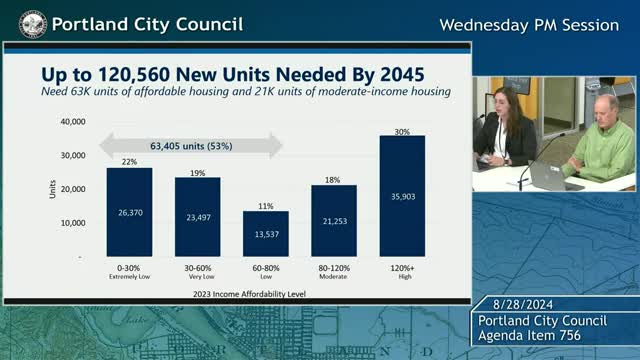Portland plans ambitious housing strategy to tackle affordability crisis
August 29, 2024 | Portland, Multnomah County, Oregon
This article was created by AI summarizing key points discussed. AI makes mistakes, so for full details and context, please refer to the video of the full meeting. Please report any errors so we can fix them. Report an error »

In a recent government meeting, officials discussed the critical findings of the 2045 housing needs analysis, which was adopted by the council last year. This analysis serves as a foundation for Portland's housing production strategy, projecting a need for approximately 120,000 new housing units by 2045 to accommodate anticipated growth across all income levels.
The analysis highlights a pressing requirement for affordable housing, estimating that around 53% of new units must be affordable for households earning at or below 80% of the area median income. This focus on affordability is crucial, especially in light of the current housing crisis affecting many residents, including those experiencing homelessness and families with diverse needs.
Current rental market conditions pose significant challenges for many Portlanders. For instance, the average rent for a one-bedroom apartment in 2023 is approximately $1,500, which is unaffordable for a three-person household earning $60,000 annually, as they would ideally spend no more than 30% of their income on housing. Furthermore, a minimum wage worker household can only afford about $760 per month, making the average one-bedroom out of reach.
To meet the projected housing demand, the city aims to produce about 5,000 new units annually until 2045. However, the analysis indicates that the highest demand is for low-income households earning between 0% to 60% of the area median income, which typically requires public subsidies. Currently, the average subsidy from the Portland Housing Bureau for these units is around $140,000 each. To address even a quarter of the identified need, an annual investment of $70 million would be necessary, while the city has averaged about $60 million per year over the past four years.
The housing needs analysis also assessed the city's zoned capacity to accommodate this growth, indicating that all district areas have surplus capacity. This presents an opportunity for targeted efforts in producing the most needed housing types and affordability levels, ensuring that Portland can effectively address its housing challenges in the coming decades.
The analysis highlights a pressing requirement for affordable housing, estimating that around 53% of new units must be affordable for households earning at or below 80% of the area median income. This focus on affordability is crucial, especially in light of the current housing crisis affecting many residents, including those experiencing homelessness and families with diverse needs.
Current rental market conditions pose significant challenges for many Portlanders. For instance, the average rent for a one-bedroom apartment in 2023 is approximately $1,500, which is unaffordable for a three-person household earning $60,000 annually, as they would ideally spend no more than 30% of their income on housing. Furthermore, a minimum wage worker household can only afford about $760 per month, making the average one-bedroom out of reach.
To meet the projected housing demand, the city aims to produce about 5,000 new units annually until 2045. However, the analysis indicates that the highest demand is for low-income households earning between 0% to 60% of the area median income, which typically requires public subsidies. Currently, the average subsidy from the Portland Housing Bureau for these units is around $140,000 each. To address even a quarter of the identified need, an annual investment of $70 million would be necessary, while the city has averaged about $60 million per year over the past four years.
The housing needs analysis also assessed the city's zoned capacity to accommodate this growth, indicating that all district areas have surplus capacity. This presents an opportunity for targeted efforts in producing the most needed housing types and affordability levels, ensuring that Portland can effectively address its housing challenges in the coming decades.
View full meeting
This article is based on a recent meeting—watch the full video and explore the complete transcript for deeper insights into the discussion.
View full meeting
